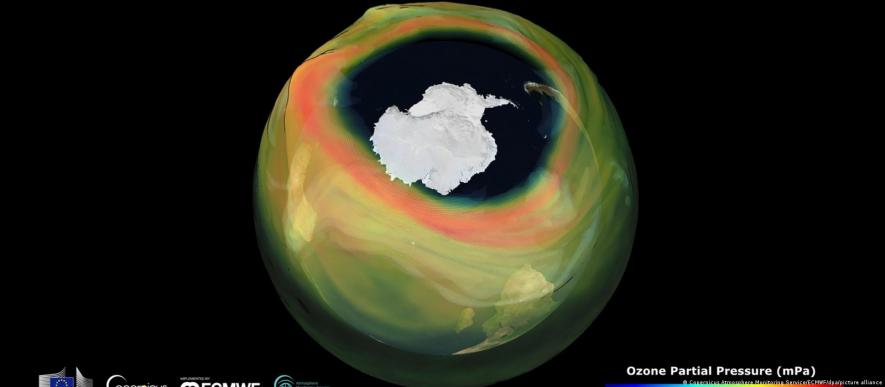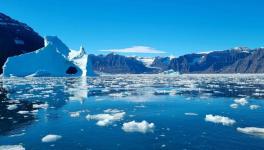Ozone Layer Recovers, Limiting Global Warming by 0.5 Celsius

When the Montreal Protocol on Ozone Depleting Substances was internationally ratified in 1989, the world came together to repair the damaged ozone layer that protects planet Earth from harmful ultraviolet (UV) radiation.
Under the agreement, reversing ozone depletion has been as simple as identifying and then banning nearly 99% of ozone-killing chemicals — including the chlorofluorocarbons that once kept fridges cool.
A UN-backed scientific panel overseeing the Montreal Protocol presented its latest four-yearly assessment on Monday, confirming the continued strengthening of the ozone layer in the upper stratosphere.
Dramatic thinning of the ozone, also known as an ozone hole, above Antarctica will be completely reversed in around four decades, the panel of experts confirmed. The smaller ozone hole above the Arctic is expected to repair much sooner.
With some ozone-depleting gases doubling as greenhouse gases, scientists predict that ozone recovery will also help fight climate change and limit temperature rise.

'A massive hole in the ozone layer' is being repaired
Beyond chlorofluorocarbons, ozone-eating chemicals including halons, methyl chloroform, carbon tetrachloride, hydrochlorofluorocarbons and methyl bromide were once abundant in refrigerators, air conditioners, aerosols, solvents and pesticides.
These compounds attack ozone by releasing chlorine and bromine atoms that degrade ozone molecules in the stratosphere.
Since the substances were banned, declining concentrations of chlorine and bromine have helped to limit human exposure to harmful UV rays from the sun that can cause skin cancer, cataracts and suppress the immune system.
"Thanks to a global agreement, humanity has averted a major health catastrophe due to ultraviolet radiation pouring through a massive hole in the ozone layer," said UN Secretary-General Antonio Guterres on the occasion of World Ozone Day last September 16. Such successful cooperation should be emulated in the fight against climate change, he added.
Restoring ozone area and depth
The ozone layer is expected to recover to its 1980 size — the year the ozone hole was officially recognized — by around 2066 over the Antarctic, by 2045 over the Arctic, and by 2040 for the rest of the world.
The assessment panel drawn from scientists at the World Meteorological Organization, United Nations Environment Program and the US National Oceanic and Atmospheric Administration, among others, did note some Antarctic ozone hole growth between 2019 and 2021.
However, these were related to meteorological extremes including the massive Australian wildfires, and the Hunga Tonga–Hunga Ha'apai volcanic eruption in the South Pacific.
The Antarctic ozone damage has ultimately been improving in area and depth since the year 2000, according to the assessment report.
Ozone restoration has positive impacts on climate change
"Ozone action sets a precedent for climate action," said Petteri Taalas, the head of the World Meteorological Organization. "Our success in phasing out ozone-eating chemicals shows us what can and must be done — as a matter of urgency — to transition away from fossil fuels, reduce greenhouse gases and so limit temperature increase."
The panel affirmed the treaty's positive impact on the climate, in part through the 2016 Kigali Amendment to the protocol that requires the phasedown of production and consumption of some hydrofluorocarbons that are also powerful greenhouse gases.
The assessment stated that this amendment alone is estimated to avoid 0.3–0.5 degrees Celsius (up to 0.9 Fahrenheit) of warming by 2100.
"By protecting plants from ultraviolet radiation, allowing them to live and store carbon, it has avoided up to an extra 1 degree C of global warming," noted UN head Guterres.
Praising the protocol's impact on both ozone and climate protection, Guterres held it up as a "universally ratified and decisively implemented" model for effective global action.
"Only by mirroring the cooperation and speedy action of the Montreal Protocol elsewhere can we stop the carbon pollution that is dangerously heating our world," he said.
"The Montreal Protocol is a success because, when science discovered the threat we all faced, governments and their partners acted," he added.
Panel warns of geoengineering side effects
Examining novel climate fighting technologies such as geoengineering for the first time, the panel also warned of unintended impacts on the ozone layer.
For the first time, the assessment panel examined how a form of geoengineering known as stratospheric aerosol injection — intended to reflect sunlight to reduce global heating — might impact the ozone layer.
The panel was concerned that an unintended consequence of the geoengineering could be a change in "stratospheric temperatures, circulation and ozone production," and therefore contribute to "destruction rates."
Edited by: Tamsin Walker
Get the latest reports & analysis with people's perspective on Protests, movements & deep analytical videos, discussions of the current affairs in your Telegram app. Subscribe to NewsClick's Telegram channel & get Real-Time updates on stories, as they get published on our website.























